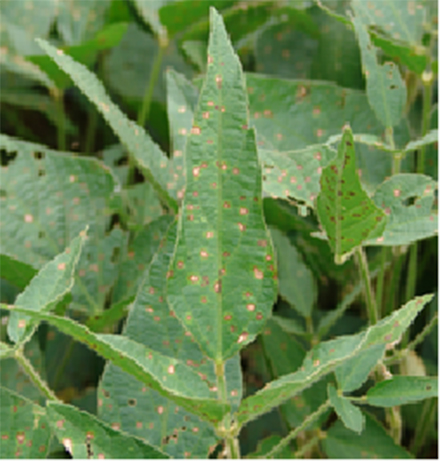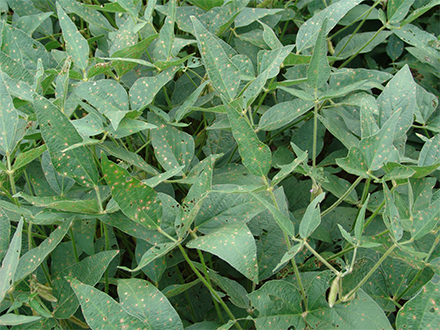G2213
Frogeye Leaf Spot of Soybean
Frogeye leaf spot is becoming more common in Nebraska soybean fields, but currently, only a few fields have been affected enough to require treatment. Management of this fungal disease includes planting resistant varieties of soybeans, proper cultural practices, and fungicide application.
Loren J. Giesler, Extension Plant Pathologist
|
Frogeye leaf spot, a fungal disease of soybean caused by Cercospora sojina, is becoming more common in Nebraska. In some years it may hasten soybean maturity by causing premature defoliation. Currently, only a few Nebraska fields have been affected severely enough to require treatment to protect soybean yields.
Estimates of national yield loss due to frogeye leaf spot have been reported to be as high as 30 percent when extensive leaf blighting occurs, but Nebraska estimated losses, even in highly susceptible varieties, are usually less than 20 percent. The disease is most severe when soybeans are grown continuously in the same field, particularly in reduced tillage systems, since the pathogen is residue-borne.
Symptoms
The primary sources of inoculum for this disease are infested residue, infected seed, and airborne spores. Infection can occur at any stage of soybean development but most often occurs after flowering, typically in the upper canopy (Figure 2).
Initial symptoms appear as small, dark spots on the leaves. These spots eventually enlarge to a diameter of about ¼ inch, and the centers of the lesions become gray to brown with reddish-purple margins (Figure 1). Individual leaf spots can further coalesce to create irregular patterns of blighting on the leaf.
Stems and pods also can be affected. Stem infections appear later in the season as long, narrow, dark lesions with flattened centers. Pod lesions are circular to elongated, slightly sunken, and reddish-brown in color. As with foliar lesions, the centers of stem and pod lesions become gray to brown as they mature. Severe pod infections can result in infected and discolored seed.
Seed symptoms will appear as gray and brown areas on the seed or as blotches or specks on the seed coat. The coats of infected seed may also crack and flake away.
Favorable Environmental Conditions
Infection occurs more readily in young leaves than in older mature leaves. This is why the disease is observed mostly in the upper canopy when it occurs late in the season. The change in susceptibility of the leaves as they develop can result in a layered occurrence of the disease in the plant canopy. Frogeye leaf spot development is favored by warm, moist weather, which promotes sporulation of the pathogen in the primary lesions. Spores of the fungus are dispersed by wind or splashing rain.
Management of Frogeye Leaf Spot
Resistance. Soybean varieties vary in their resistance to frogeye leaf spot. Several genes commonly are used for resistance.
Cultural Practices. Frogeye leaf spot is more severe in continuously cropped soybean fields. Reduced tillage systems will tend to have greater incidence of this disease, as the pathogen overwinters in residue. While infected crop residue is probably a more significant source of inoculum, infected seed may introduce the fungus to new areas.
Fungicide Application. Application of fungicides to manage frogeye leaf spot in Nebraska is typically not warranted in most fields. Fields with a history of the disease should be watched carefully. If disease develops, application of a strobilurin fungicide at the R3 growth stage (pod set) is considered the most effective approach. However, in 2010, resistance of Cercospora sojina to strobilurin fungicides was reported for the first time in Tennessee. Since that time, resistance also has emerged in the Mississippi Delta region of the U.S.
Fungicide applications that don’t result in expected control may be an indication that resistance has spread. This will most likely not be an issue in Nebraska for several years. Use of cultural practices and growing resistant varieties are effective management strategies that also will reduce the potential for development of fungicide resistance in pathogen populations.
This publication has been peer reviewed.
Visit the University of Nebraska–Lincoln Extension Publications website for more publications.
Index: Plant Diseases
Soybean
Issued September 2013

